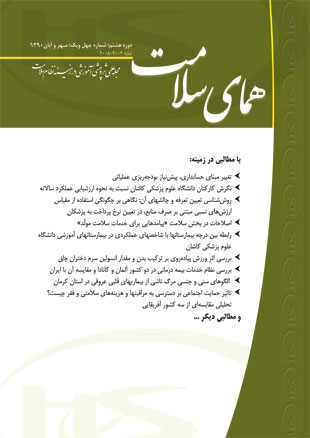فهرست مطالب

دو ماهنامه همای سلامت
سال هشتم شماره 1 (پیاپی 38، فروردین و اردیبهشت 1390)
- تاریخ انتشار: 1390/10/10
- تعداد عناوین: 11
-
صفحه 4
-
صفحه 5
-
Page 6The Burnout syndrome among the staff of hospitals has increased in the recent years and their health is being at risk. The purpose of this study was to determine the prevalence of burnout syndrome among the staff of a selected hospital in Isfahan. This is a crosssectional analytical study which was conducted with the participation of 96 employees. The study subjects were employed at the hospital within the research year. The subjects were selected through convenience sampling. The data was gathered by demographic questionnaire and Maslach burnout inventory. The data was also analyzed by descriptive and analytical statistics. (TTest and Chi square) The results showed 53.4% with moderate to high levels of emotional exhaustion, 71.4% with moderate to high levels of inefficiency and 56.9% with moderate to high levels of depersonalization and pessimism About the intensity scale of burnout, 39.4% of those with moderate to high levels of emotional fatigue, 75.3% moderate to high levels of inefficiency and a 59.5% moderate to high levels of depersonalization and paranoia have been reported. The Burnout syndrome in female employees was seen more than men. It seems necessary to take the mental health of the staff into consideration as an important goal. This prevents many of the factors that affect mental and physical diseases. Thereby, this is an step toward increasing the efficiency and productivity of the employees.
-
Page 10The purpose of health service providers is to maintain health in society. The mission of the health system providers is acheived through the provision of appropriate services and evaluating this system is gained through the paitients’ satisfaction. Thus, Patients’ satisfaction is one of the important indicators of quality health care. This is an analytical descriptive study in which 96 patients were randomly selected and their satisfaction from hospital’s different service wards was measured by a questionnaire. Results showed that 25% of the patients were completely satisfied with the hospital, 63.5% satisfied, 10.4% dissatisfied and 1% were completely dissatisfied. The utmost satisfaction was expressed with the ease of access to the reception on arrival at the hospital (94.8%) and the least satisfaction was expressed with the noise in the hospital wards(33.3%), It is essential for the hospital administrators to consider the dissatisfaction factors. Health system managers should seek strategies to improve the quality care of hospital and the satisfaction of health system clientele.
-
Page 15Science and technology have a significant impact on health services and have risen the services’ costs. The raise in the society awareness has led to a demand for better quality services. This article firstly, provides a definition for standard and then, discusses the successive steps towards setting standards and their features. Finally, it is explained how we can make sure about the validity of the standards and whether they’re attained or not.
-
Page 19Hospital is an important structure to provide health services and it is also known as a costly service in health care. About 60 percent of the hospital operating costs is related to its employees. Thus, it is important to optimize the number of employees. To evaluate the manpower, it is of great significance to consider the number of employees and their workload. The most practical method to do so is the work study method. This method provides the possibility of a realistic planning and improving the productivity and efficiency. This study is aimed to determine the effective working time of the emergency staff in Chamran Hospital, Esfahan city.
-
Page 24The concept of information need and its importance in the hospital has great significance. Obstacles for supplying information needs must be investigated and removed. The aim of this study was to determine the conformity of the hospital library services and resources with the personnel information needs. This is an analytical descriptive research.The subjects of the study were chosen from the personnel of Fatemeh Zahra hospital in Najafabad. 110 employees were selected by a simple random sampling. Data was gathered by the questionnaires and it was analyzed by descriptive and analytic statistics. Results showed that the information need of the hospital staff is not in good compliance with library services and resources. From the staff point of view, the conformity level is low to moderate, in most cases. Variables such as sex and educational level are effective in this issue. It seems that to update the library resources and services, the staff common needs should be assessed periodically. And to study this conformity with the living standards, some actions must be taken.
-
Page 28One of the biggest challenges in the world is to finance and to provide health care services for more than a population of 1.3 billion in the poor rural areas and the workforce of the informal sector in countries with low and average incomes. Most of the community-based financing plans have been created in a setting with severe economic constraints, political instability, and public sector failures. Micro-level household data analysis indicates that community-based financing increases the availability of the needed health care services for the rural and the workforce of the informal sector, improves the quality and reduces the financial burden on the members. The Key policies below are presented for more effectiveness and sustainability of community-based financing schemes by the previous researches: Targeting subsidies to pay the insurance premiums of the vulnerable members Insuring people to protect them against expenditure fluctuations and taking out re-insurance to enlarge the effective size of small risk pools Technical support to strengthen the management capacity of local schemes Establishment and strengthening of link with the formal financing and provider networks.
-
Page 32Organizational commitment is an important factor in personnel's behavior and organizations output and efficiency. Committed personnel feel themselves dependent to the organization and find their goals as the organization goals. Thus, they will make their effort to achieve the organizational goals and will identify themselves with those goals and will affiliate themselves to their organization. Commitment to one’s organization is of great importance in hospital personnel since hospital staff have a critical place in saving patients’ lives. This study aims at determining the relationship between job -related and personal characteristics and organizational commitment in the personnel of educational hospitals of Hamedan University of medical sciences. This is a cross-sectional study and its samples were chosen from the managers and staff of the mentioned hospitals. 137questionaries were completed and the data was analyzed with descriptive and analytic statistics. The results showed that there is a meaningful relationship between sex, age, record of service, duty branch, level of activity and organizational commitment, Also, Salary, education, type of recruitment, marriage and shift, do not indicate any meaningful relationship. The Organizational commitment in men is more than women and it is increased with age and their history of hospital work. The managers have more organizational commitment than other staff and the medical staff have the least commitment. Commitment in senior managers is more than other managers and personnel as well. Based on the results, the level of organizational commitment can change with the factors of gender, age, record of service, field and level of activity.
-
Page 38There is competition between hospitals and other health care service providers in many cases. It seems that this competitive environment will lead to a more effective and better service. Thus, governments are increasingly focusing on the application of competition rules to hospital services. Basically; rules of competition do not play any roles in focused and order and control-based services. In contrast, when the competition spreads among hospitals, they will try to reduce the competitive forces and those which have been operating independently will be merged to protect themselves against the competition pressure. When the hospital facilities integrate, this merging can reduce the operating costs. In the absence of market power, competition works most effectively. One of the aspects of market power is high demand versus limited supply of services. To convince the hospitals with the market power to reduce costs and increase efficiency, relying on competition is not a reasonable expectation. Market-oriented solutions will work only when other proper alternatives are available. It means that if policy makers focus on competitive solutions, policies to prevent anticompetitive merging will be of great significance.


